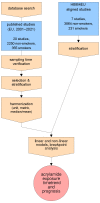Time Trends of Acrylamide Exposure in Europe: Combined Analysis of Published Reports and Current HBM4EU Studies
- PMID: 36006160
- PMCID: PMC9415789
- DOI: 10.3390/toxics10080481
Time Trends of Acrylamide Exposure in Europe: Combined Analysis of Published Reports and Current HBM4EU Studies
Abstract
More than 20 years ago, acrylamide was added to the list of potential carcinogens found in many common dietary products and tobacco smoke. Consequently, human biomonitoring studies investigating exposure to acrylamide in the form of adducts in blood and metabolites in urine have been performed to obtain data on the actual burden in different populations of the world and in Europe. Recognizing the related health risk, the European Commission responded with measures to curb the acrylamide content in food products. In 2017, a trans-European human biomonitoring project (HBM4EU) was started with the aim to investigate exposure to several chemicals, including acrylamide. Here we set out to provide a combined analysis of previous and current European acrylamide biomonitoring study results by harmonizing and integrating different data sources, including HBM4EU aligned studies, with the aim to resolve overall and current time trends of acrylamide exposure in Europe. Data from 10 European countries were included in the analysis, comprising more than 5500 individual samples (3214 children and teenagers, 2293 adults). We utilized linear models as well as a non-linear fit and breakpoint analysis to investigate trends in temporal acrylamide exposure as well as descriptive statistics and statistical tests to validate findings. Our results indicate an overall increase in acrylamide exposure between the years 2001 and 2017. Studies with samples collected after 2018 focusing on adults do not indicate increasing exposure but show declining values. Regional differences appear to affect absolute values, but not the overall time-trend of exposure. As benchmark levels for acrylamide content in food have been adopted in Europe in 2018, our results may imply the effects of these measures, but only indicated for adults, as corresponding data are still missing for children.
Keywords: HBM; acrylamide; exposure level; glycidamide; human biomonitoring; time-trend.
Conflict of interest statement
The authors declare no conflict of interest.
Figures







Similar articles
-
Trends of Exposure to Acrylamide as Measured by Urinary Biomarkers Levels within the HBM4EU Biomonitoring Aligned Studies (2000-2021).Toxics. 2022 Aug 2;10(8):443. doi: 10.3390/toxics10080443. Toxics. 2022. PMID: 36006122 Free PMC article.
-
Harmonized human biomonitoring in European children, teenagers and adults: EU-wide exposure data of 11 chemical substance groups from the HBM4EU Aligned Studies (2014-2021).Int J Hyg Environ Health. 2023 Apr;249:114119. doi: 10.1016/j.ijheh.2023.114119. Epub 2023 Feb 9. Int J Hyg Environ Health. 2023. PMID: 36773580 Review.
-
Harmonization of Human Biomonitoring Studies in Europe: Characteristics of the HBM4EU-Aligned Studies Participants.Int J Environ Res Public Health. 2022 Jun 1;19(11):6787. doi: 10.3390/ijerph19116787. Int J Environ Res Public Health. 2022. PMID: 35682369 Free PMC article.
-
Human biomonitoring initiative (HBM4EU) - Strategy to derive human biomonitoring guidance values (HBM-GVs) for health risk assessment.Int J Hyg Environ Health. 2020 Sep;230:113622. doi: 10.1016/j.ijheh.2020.113622. Epub 2020 Oct 9. Int J Hyg Environ Health. 2020. PMID: 33045523
-
Cadmium exposure in adults across Europe: Results from the HBM4EU Aligned Studies survey 2014-2020.Int J Hyg Environ Health. 2022 Sep;246:114050. doi: 10.1016/j.ijheh.2022.114050. Epub 2022 Oct 17. Int J Hyg Environ Health. 2022. PMID: 36265402 Review.
Cited by
-
Editorial: Dietary acrylamide in human health.Front Nutr. 2024 Jun 25;11:1446690. doi: 10.3389/fnut.2024.1446690. eCollection 2024. Front Nutr. 2024. PMID: 38983801 Free PMC article. No abstract available.
-
Determinants of exposure to acrylamide in European children and adults based on urinary biomarkers: results from the "European Human Biomonitoring Initiative" HBM4EU participating studies.Sci Rep. 2023 Dec 2;13(1):21291. doi: 10.1038/s41598-023-48738-6. Sci Rep. 2023. PMID: 38042944 Free PMC article.
-
Dietary and Smoking Acrylamide and Prostate Cancer Risk: CAPLIFE Study.Nutrients. 2024 Mar 14;16(6):836. doi: 10.3390/nu16060836. Nutrients. 2024. PMID: 38542747 Free PMC article.
-
Results of the BfR MEAL Study: Acrylamide in foods from the German market with highest levels in vegetable crisps.Food Chem X. 2024 Apr 23;22:101403. doi: 10.1016/j.fochx.2024.101403. eCollection 2024 Jun 30. Food Chem X. 2024. PMID: 38694545 Free PMC article.
-
Internal exposure to heat-induced food contaminants in omnivores, vegans and strict raw food eaters: biomarkers of exposure to acrylamide (hemoglobin adducts, urinary mercapturic acids) and new insights on its endogenous formation.Arch Toxicol. 2024 Sep;98(9):2889-2905. doi: 10.1007/s00204-024-03798-z. Epub 2024 May 31. Arch Toxicol. 2024. PMID: 38819476 Free PMC article.
References
-
- EFSA Panel on Contaminants in the Food Chain (CONTAM) Scientific Opinion on Acrylamide in Food. EFSA J. 2015;13:4104. doi: 10.2903/j.efsa.2015.4104. - DOI
-
- Mesias M., Delgado-Andrade C., Morales F.J. An Updated View of Acrylamide in Cereal Products. Curr. Opin. Food Sci. 2022;46:100847. doi: 10.1016/j.cofs.2022.100847. - DOI
Grants and funding
LinkOut - more resources
Full Text Sources
Research Materials

